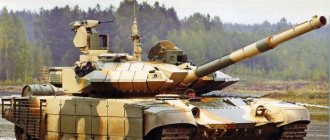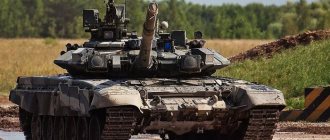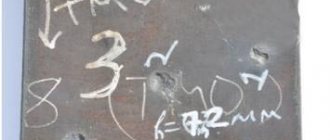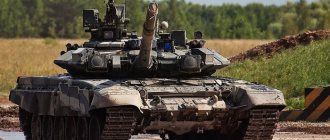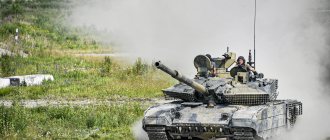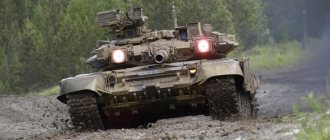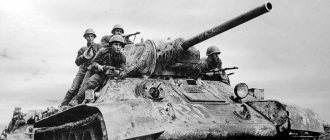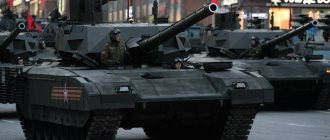Main battle tank T-90MS. Protective lattice screens are clearly visible. In February 2020, the international exhibition IDEX 2022 was held in Abu Dhabi, during which the latest models of various weapons were demonstrated. The real “star” of the Russian part of the exhibition was the T-90MS main battle tank. It should be noted that potential customers showed significant interest in this car even before its first open official display. Representatives of Kuwait and Egypt, in particular, spoke about their intention to purchase large quantities of such tanks, but India has moved further than others - a contract for the supply of more than four hundred T-90MS to this country is currently at the signing stage, negotiations are ongoing.
History of creation
As is known, the collapse of the USSR and the subsequent collapse of the Russian economy dealt a particularly heavy blow to defense enterprises. The Uralvagonzavod corporation was no exception, whose financial situation at the beginning of the twenty-first century was extremely sad. Who knows what could have happened in the future with this enterprise if it had not been for the signing of the 2001 contract with India. The agreement, which was life-saving for Uralvagonzavod, provided for the production of a large number of T-90 tanks, or more precisely, their export modifications T-90S and T-90SK (commander version).
The economic effect of this transaction made it possible not only to save the corporation, but also to continue research and development work (R&D). In those years they went in two main directions. The first of these was the development of the Russian “tank of the future”, known as the T-95 (this project was later abandoned in favor of the T-14 Armata), and the second involved the modernization of the T-90.
Tank T-90A, the “ancestor” of the T-90MS at the tankodrome. The photo was taken in 2010
Starting in 2004, mass production of the T-90A model was launched, which was immediately adopted by the Russian army. A couple of years later, an export modification of this combat vehicle, the T-90SA, appeared. At the same time, apparently, work began on the “Breakthrough-2” theme, the goal of which was to further increase the capabilities of the tank. True, at first representatives of Uralvagonzavod preferred to talk about the creation of some kind of “universal combat module.”
One way or another, by 2011, when serial production of the T-90A was suspended, a modernized version of this tank was created, designated T-90AM. However, its export modification, the T-90SM, which was first demonstrated at the REA-2011 exhibition in Nizhny Tagil, received the greatest “media” fame.
The new tank differed in many ways from the base model. In particular, it received a new 2A46M-5 cannon and a V-92S2F engine with power increased to 1,130 horsepower. In addition, the layout of the ammunition, the shape of the turret and the composition of the on-board electronic equipment have changed. One of the most noticeable innovations was the appearance of the T05BV-1 UDP installation. It replaced the previous Utes anti-aircraft machine gun.
The T-90SM could perhaps repeat the success of its immediate predecessor, the T-90S, which in the first decade of the twenty-first century became the best-selling tank worldwide, with export volumes exceeding one and a half thousand. Purely political factors prevented this - in 2014, the crisis in Ukraine began, which became the reason for the introduction of economic sanctions against Russia.
Indian tank crews on the T-90S
As a result, Kuwait, which showed considerable interest in the modernized export modification of the T-90, chose not to quarrel with the United States and stopped negotiations with Uralvagonzavod. Other potential customers followed this example.
Over the next few years, this uncertain situation persisted, but the designers continued work on modernizing the tank. They were carried out within the framework of the “Breakthrough-3” project, the result of which was the appearance first of the T-90M, and then of the T-90MS.
Unfortunately, from the numerous publications devoted to these tanks, it is sometimes impossible to understand how the T-90SM and T-90MS differ from each other and whether they are the same vehicle. In particular, it was reported that the T 90MS tank, the exact characteristics of which remained unknown, was allegedly successfully tested in Kuwait back in 2014, and in some places this vehicle has already been called the best-selling vehicle in the world. At the same time, in articles from 2020, the T-90MS modification is called a newly introduced new product. It turns out that in 2014 we could have been talking more about the T-90SM. It is premature to talk about any commercial success, since there is not a single approved contract yet.
To avoid confusion, you can try to find out what the difference is between the T-90MS and T-90SM. This is not so easy to do, since both names were actually used for quite a long time to refer to the same tank, which first appeared in 2011. A significant part of the changes that have occurred since then as part of the Breakthrough-3 project are likely to be in the hardware and software of the combat information control system (CIUS). But that's clearly not all.
Main components of the 2A46A-5 gun (below), installed on the T-90MS
It is necessary to remember that the T-90AM was equipped with a 2A46A-5 gun, while the T-90M was equipped with a 2A82 gun, “borrowed” from the latest Russian Armata tank. It is prohibited to export the 2A82; this weapon is intended only for the Russian army. Thus, the T 90MS tank will not receive it. However, back in 2017, reports appeared that this vehicle, depending on the customer’s wishes, could be equipped with 2A46M-5 guns (the same as on the T-90AM and T-90SM), 2A46M-5-01 and 2A46M-6.
No detailed information about the 2A46M-6 has yet been published, but it can be assumed that this gun is some kind of “compromise” option - worse than the 2A82, but better than the 2A46M-5. In the meantime, on the Uralvagonzavod website the T-90MS is shown with the same gun as the T-90SM. In a word, the confusion continues, but there is a possibility that after the tank is rearmed and its development is fully completed, the situation will become clearer.
Device
The T-90AM tank has a V-shaped engine consisting of twelve cylinders, produced at the Chelyabinsk Tractor Plant. The engine is four-stroke and is marked V-92S2F. It differs from its predecessors in the quality of casting, connecting rods and pins of increased strength, reinforced pumps, crankcases and injectors.
Nitriding technology was used in the production of the crankshaft. The essence of the method is to coat the surface of parts with an alloy saturated with nitrogen, which can significantly increase resistance to corrosion and wear. In case of malfunction of the T-90AM tank engine, the crew is notified.
Innovative methods were also embodied in the implementation of the principles of nutrition of the V-92S2F. The engine is diesel and is capable of starting at a minimum temperature of −20 °C. However, it is believed that the operating temperature range varies from −50 °C to +50 °C.
Main goals and objectives
The T-90MS tank is designed to conduct active offensive or defensive combat in conditions of strong opposition from the enemy. His tasks include:
- Supporting motorized rifle units, suppressing and destroying enemy firing points directly on the battlefield;
- Breaking through the enemy's defense system, destroying his artillery;
- Fight against tanks and other enemy armored vehicles;
- Deep raids with the destruction of transport convoys, ammunition depots and equipment in the enemy operational rear;
- Conducting reconnaissance.
Thus, the T-90MS is a flexible and fairly universal means of conducting maneuver warfare.
Booking
The T-90AM is partially equipped with Afghanit active protection units. It is a set of measures to aggressively counter the enemy in the event of an attack by a combat unit.
The Afghanit complex itself includes short- and long-range pulse-Doppler radars, ultraviolet direction finders, as well as a robotic controlled machine gun mount to counter incoming ground-to-ground and air-to-ground projectiles.
The Afghanit is fully equipped on the T-14 of the Armata family, partial installation, as mentioned above, is on the T-90AM, and on the export version of the T-90MS it is possible to integrate the Arena-E system, which is in many ways similar above, but has significant functional limitations. Thus, all the splendor of advanced technologies will not be exported, and all the benefits will be enjoyed by members of the T-90AM crew in the Russian army.
Design Features
Model of the T-90MS tank
The T-90MS is a tank of a classic layout with a front control compartment, which houses the driver, a middle fighting compartment, “topped” with a turret, where the commander and gunner are located, and a rear engine and transmission compartment. The vehicle is equipped with a combat information and control system, part of which is the Kalina fire control system.
The OMS includes, in particular, the following elements:
- PC PAN "Hawkeye". This panoramic sight, designed for a tank commander, was developed in Belarus. It is installed not only on the T-90MS, but also on the T-72B1MS;
- PNM "Sosna-U". The sight is intended for the gunner, it is possible to use a thermal imaging channel and a laser rangefinder;
- Device for automatic target tracking;
- Stabilizer;
- Device for determining nationality.
The Kalina fire control system makes it possible to implement the “hunter-shooter” principle, which implies the rapid “transfer” of identified priority targets to the gunner. This approach ensures a shot at the enemy immediately after he appears in the gun’s destruction sector.
The “hunter” can be either the commander of a combat vehicle using a panoramic sight or another tank. This ensures tactical interaction on the battlefield. The greatest effectiveness can be achieved by T-90MS units receiving target designations from the T-14 Armata.
In general, this approach coincides with the requirements of the concept of network-centric warfare, which implies constant interaction and complete coordination between all direct participants in the battle.
Type of reservation and protection systems
The rear part of the T-90MS turret with an armored box.
The photo shows a vehicle that has been on display since 2011. The T-90MS tank has combined multi-layer armor of differentiated thickness. Lattice screens are installed on the sides and rear of the tank. The rear part of the turret is additionally covered with an armored box.
Almost the entire tank is covered with 4S22 Kontakt-5 modular dynamic protection elements. This distinguishes the T-90MS from the T-90AM and T-90M, which use the newer DZ 4S23 “Relikt”, the export of which is currently prohibited.
An important feature of the T-90MS (and T-90SM) is the absence of the Shtora system, designed for protection against anti-tank guided missiles, as part of the basic configuration. Its installation can be done at the request of the customer. Considering that the Shtora has already proven its effectiveness during the battles in Syria, most buyers are unlikely to refuse it.
The situation is the same with the active protection complex - it is not present on the T-90MS demonstration models, but it can be installed. True, it is not yet possible to purchase the Afghanit that the T-90M is equipped with. Export tanks are expected to be equipped with Arena-E active protection.
To prevent the tank from being blown up by a mine with magnetic fuses, the SPMZ-2E system is used. Protection against secondary fragments formed during an external impact on the armor is provided by screens made of aramid fabric.
Powerplant, transmission and suspension
The power plant for the T-90MS tank is the V-92S2F multi-fuel diesel engine (original name - V-93). Its test cycle was completely completed in 2017, but it was installed on the T-90SM and T-90AM in 2011. The power of this engine is 1130 horsepower.
Multi-fuel engine V-92S2F
The new engine made it possible to significantly increase the thrust-to-weight ratio and mobility of the T-90SM tank. In the future, it is planned to equip these machines with an even more powerful and modern V-99 engine.
Additionally, an auxiliary diesel generator set is installed on the tank - it is located on the side fender and is designed to supply electricity to on-board equipment when the main engine is turned off.
The transmission design is largely unchanged; the same seven forward and one reverse gears as on the original T-90A are retained. There is an automatic gearshift - mechanisms of this type in ordinary cars are usually called “robot gearbox”; they should not be confused with conventional hydromechanical automatic transmissions.
The suspension, judging by the photographs of the tank, is practically no different from that of the T-90A - an individual torsion bar. The smoothness of the ride can be judged by the results of practical application. Control is carried out using a rotary steering wheel.
Highlights
The T-90AM has several design features.
Firstly, this is the location of the exhaust system in the pipes above the tracks. This is due to the desire of the designers to reduce the temperature of the body, which significantly complicates the task for location systems of a mock enemy operating on the basis of thermal energy recognition. For example, infrared guidance systems for missiles of various classes.
Secondly, for the successful operation of the T-90AM, the Russian army implemented a control system based on a steering wheel - similar to the system of aircraft and watercraft. The gearbox implies both an automated mode of operation and a transition to manual control.
Thirdly, the surveillance system has been modernized, including a modern set of night vision devices for the driver and video cameras for viewing from the rear.
Specifications
The main parameters of the T-90MS tank, published by Uralvagonzavod, are as follows:
| Total tank weight | 48 tons |
| Maximum highway speed | 60 km/h |
| Fording depth | 1.8 m |
| Width of water obstacle overcome along the bottom (with OPVT equipment) | Up to 1000 meters, depth up to 5 meters |
| Engine power | 1130 horsepower. |
| Power reserve | Up to 550 km |
| Tank target recognition range | 5,000 m along the optical channel, 3,500 along the thermal imaging channel |
| Turret traverse speed | At least 40 degrees per second |
| Crew | 3 persons |
| Power density | 24 hp per ton |
The speed of movement along country roads and dirt is not given in official sources. This characteristic is supposedly 35-40 km/h.
T-90 tests
Tests (testers Anatoly Bakhmetov and Dmitry Mikhailov)
It is no secret that the equipment is undergoing testing (research and acceptance). The program for the T-90 was very complex. In the beginning there was a “cockroach race”, i.e. Having filled the fuel tanks to the maximum, they had to undergo tests on concrete. 1700 liters filled, 728 km covered non-stop (power reserve stated 600 km). This is the result of the use of a unique in world practice engine-transmission unit and in the method of motion control. On the highway, the load on all components of the tank is maximum destructive, 3500 km were covered, the average speed was 49 km/h (every 4 hours, crew change in 2 minutes). In practice, only the T-72 never lost its tracks (“disease” of the T-64s), even in difficult mountain or urban conditions. And the T-90 received a better design, with a rubber treadmill (from the T-80) for roller tires. For example, in 2016, the best NATO tank “Leopard2A7” needs to change the track 6 times (every 1000 km) compared to the Russian T-90 (6000 km).
The tests continued with a night run of 250 km, the power plant was cooled by 35 hp. liquid, instead of the required 90 liters. Test mechanic A. Shopov noted the reliability of the engine when overheating. In practice, there were cases of leakage of all the coolant and the tank could travel 2.5 km (including the T-72). And winter engine starting has been reliable since the days of the T-72. This indicates an excellent engine lubrication system. For a tank weighing up to 50 tons, the B-84 engine was sufficient, but India ordered a more powerful power plant for the T-90. The next stage of testing the T-90 was an 8-hour run through pits and potholes with the fire control system turned on. The testers pushed everything, the gun stabilizer squealed from overload, and the hydraulic stop was constantly activated. The gunner rotated the turret by 360° every 2.5 minutes ("transfer speed" mode).
The human factor can become decisive in the design; this did not happen with the T-90. During one of the tests in Turkmenistan, a conscript soldier drove the tank “carefully” so as not to repair the vehicle, a plant representative “admonished” him to do this (for fear of failing the speedy acceptance). Experienced comrades explained that people’s lives depended on testing the machine and fulfilled their duties to the end. The tank underwent repeated and comprehensive testing. In winter in Siberia, the car was driven by an inexperienced mechanic-driver (he had previously spent 2 days as a passenger-observer), he completed the task in 2 hours, a meter-long layer of snow reduced the speed of the tank to 23 km/h.. 7 days passed and the soldier overcame long snow-covered areas with a layer of up to 1.5 m, at a speed close to professionals 35 - 41 km/h.
Armament
Remote controlled installation T05BV-1
The T-90MS tank is equipped with an artillery gun and two machine guns. One of them is paired with a gun, and the second is located in a remotely controlled installation T05BV-1, mounted on the turret.
The main feature of the T05BV-1 is a noticeably expanded range of vertical rotation angles. With the help of a machine gun mounted in this installation, you can equally successfully fire at air targets and fire at enemy infantry that has gotten close to the tank itself, in the “dead zone”.
On the “demonstration” T-90SM tanks, shown back in 2011, a 6P7K machine gun (PKTM variant) of 7.62 mm caliber was mounted in the T05BV-1 mount. Of course, this is too weak a weapon for firing at air targets and many other types of combat. Therefore, it is possible to replace it in the field with a 12.7 mm machine gun (“Kord” or “Utes”), or with an AGS-17 automatic grenade launcher.
A gun
The T-90SM tank, shown in 2011, was equipped with a 2A46M-5 gun. It was developed in 2006 at Plant No. 9 in the city of Yekaterinburg and was originally intended for the T-72B2. The main and most noticeable difference between this gun and earlier modifications of the 2A46 is the presence of a barrel bending device. Thanks to him, it was possible to significantly increase the accuracy of fire, especially in the intense firing mode, which is accompanied by strong heating of the gun.
In 2017, information appeared that the T-90MS would be equipped with a 2A46M-6 gun, the characteristics of which can only be guessed at.
Ammunition
Invar 9M119M guided missile
The gun of the T-90MS tank can fire all modern types of 125 mm ammunition created for the 2A46 family. These are cumulative, sub-caliber, high-explosive fragmentation, practical and training shells of various types.
In addition, the Invar and Invar-M (9M119M and 9M119M1) guided missiles of the Reflex-M complex with a tandem warhead can be launched through the gun barrel. They provide penetration of armor up to 900 mm thick. The maximum sighting range is 5 kilometers, guidance is carried out using a laser beam. Can be used against air targets. There is also an option with a thermobaric warhead, which makes it possible to use these missiles against enemy infantry and field fortifications.
The total number of shells and guided munitions is, according to various sources, from 40 to 45 units. The ammunition is placed separately, in the autoloader carousel (22 shots), in the rear armored box (10 or 15 shots) and in a stowage near the logistics partition (8 shots).
The 6P7K machine gun, coaxial with the cannon, is equipped with two thousand rounds of ammunition. The amount of ammunition for installing the T05BV-1 is determined by the type of weapon used. For a regular machine gun it is 800 rounds of ammunition, for a large-caliber machine gun it is at least three hundred.
World market
According to a Western publication called The National Interest, the new combat vehicle is among the top five best tanks in the world.
Approximately 27% of the global market is captured by Russian-made weapons. This is an honorable second place (the first place still belongs to the USA). In recent years, income from the export of domestic weapons has remained within $15 billion. Unfortunately, it is very difficult to calculate what share of this amount belongs to the Ural plant, but it is worth noting that the cost of the export model T-90MS is approximately 4 million US dollars. For comparison, the most advanced French tank, the AMX-56 Leclerc, is considered very expensive (about 12 million US dollars).
Even Ukrainian news about an armored tank plant in the city of Lvov in the media is accompanied by illustrations of the Russian T-90AM tank.
Modifications
To date, only one additional modification of the T-90MS tank is known. This is the T-90MSK, the “commander” version of the combat vehicle. It has not yet been demonstrated, but a preliminary agreement on the supply of such tanks has already been reached with India. Apparently, the T-90MSK will differ from the basic modification by an expanded composition of communications equipment and, possibly, an upgraded combat information and control system at the tactical level.
Tank T-90MS during testing
Abroad
In July 2022, information surfaced that practically “space” technologies embodied in the T-90M did not go unnoticed by the world press and governments of other countries.
An agreement was concluded with Iraq, in the first stages of implementation of which it is planned to export 73 T-90MS units to this country. The success of the deal is due not only to the high efficiency of the new combat unit, but also to the growing military threat in the Middle East. Saudi Arabia also paid attention to the new tank.
The T-90 model is also produced in India under a Russian license. It is known that about 70% of Indian weapons are produced in Russia.
The agreement for the supply of 100 T-90 units to Azerbaijan has almost been completed. Previously, more than 120 samples of the same model were exported to Algeria.
Advantages and disadvantages
The T-90MS tank meets all the basic requirements of modern combat, which is due to a number of its positive qualities:
- High level of security. In this parameter, the new vehicle should be ahead of the T-90A, which has proven itself well in Syria;
- Excellent characteristics of the fire control system;
- The level of safety for the crew has increased significantly. The autoloader carousel received additional protection, the rest of the ammunition was spaced out;
- The tank has a high power output, which makes it mobile and maneuverable.
It’s probably too early to talk about the shortcomings, but at least two disadvantages can be noted - insufficient armor penetration of the main types of projectiles and the unfortunate location of the diesel generator set, which is very vulnerable to enemy fire.
It is interesting that although the T 90MS tank has not yet been tested in the United States, American experts have already made various assessments of this combat vehicle, comparing it with the M1A2 Abrams and usually coming to the traditional conclusion about the total superiority of their own equipment.
Application
T-90MS or SM tank in Kuwait
T-90MS tanks did not appear on the battlefield for obvious reasons. There is very little information about their tests. It is known that even in the T-90SM version they were successfully tested in Kuwait in desert conditions. In February 2022, videos were published showing live firing with the participation of the T-90MS, but nothing special was shown. Moreover, representatives of the Ministry of Defense subsequently stated that the demonstration was in fact T-90M tanks intended for the Russian army.
This situation may change in the very near future, since the contract with India is on the verge of being signed, and if it is concluded, full-fledged military tests will have to be carried out, information about which will inevitably end up in the press.
In the army
The T-90AM tank represents an innovation in the domestic defense industry. It serves as further proof that military design ideas do not stand still and the modernization of previously implemented projects does not stop for a minute.
There is no exact information about how many T-90AMs are currently in the Russian army (this information is at least secret). However, there are references to the fact that a certain number of “third breakthroughs”, that is, T-90M, have been ordered. And this is logical! It is stupid to use a conditionally undeveloped version of the T-90AM in the Russian army if an advanced model already exists.
